Lanchester, Durham
Up to 1834
A parliamentary report of 1777 recorded local workhouses in operation at Tanfield (for up to 30 inmates) and Kyo (20 inmates).
Eden, in his 1797 survey of the poor in England, reported that Tanfield:
After 1834
Lanchester Poor Law Union formally came into existence on 4th January 1837. Its operation was overseen by an elected Board of Guardians, 21 in number, representing its 18 constituent townships as listed below (figures in brackets indicate numbers of Guardians if more than one):
County Durham:
Benefieldside, Billingside, Collierly Pontop, Conside and Knitsley, Cornsay, Esk, Ebchester, Greencroft, Healeyfield, Hedleyhope, Iveston, Kyo Laws, Lanchester (2), Langley, Medomsley, Muggleswick, Satley, Tanfield (3).
Later Additions: Craghead (from 1896), Knitsley (from 1894), South Moor (from 1894), Oxhill (1894-1916), Stanley (from 1894).
The population falling within the Union at the 1831 census had been 7,924 with townships ranging in size from Billingside (population 18) to Tanfield (2,478) and Lanchester itself (1,210). The average annual poor-rate expenditure for the period 1834-36 had been £3,077 or 7s.9d. per head of the population.
A new Lanchester Union workhouse was built on Newbiggin Road in Lanchester in the late 1830s. The workhouse location and layout are shown on the 1895 map below.
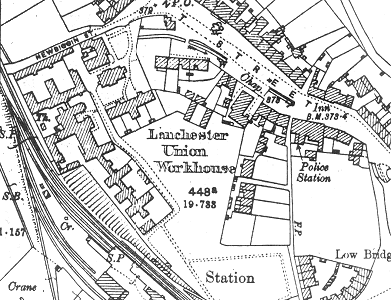
Lanchester workhouse site, 1895
At the north of the site, the front range of the workhouse probably contained the original offices and Guardians' board-room.
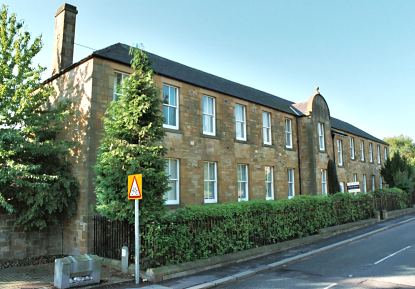
Lanchester workhouse front range from the north-east, 2001.
© Peter Higginbotham.
There was an irregular block to its rear, and at the south stood an H-shaped building which may have been the original infirmary. The buildings at the east probably contained casual wards for vagrants and receiving wards for new inmates.
In 1894, the British Medical Journal set up a "commission" to investigate conditions in provincial workhouses and their infirmaries. Following a visit to Lanchester, the commission's report was broadly complimentary about conditions in the institution. Its recommendations included the employment of a trained night-nurse and the provision of extra accommodation for offensive and isolation cases. The toilets were of the earth closet type but generally appeared to lack the necessary supply of earth needed to deodorise their contents. Further details are available in the full report.
The site developed to the east between 1880 and 1910 with additions including a hospital, union offices, and cottage homes for children, all of which appear on the 1915 map below.
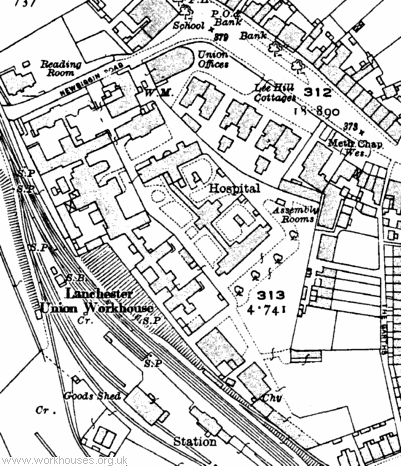
Lanchester workhouse site, 1915
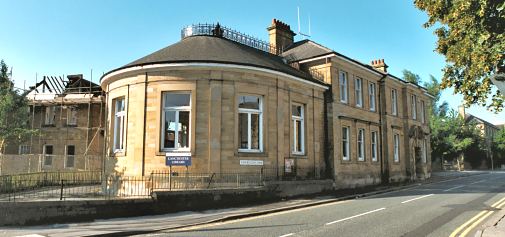
Lanchester Union offices from the north-east, 2001.
© Peter Higginbotham.
Most of the buildings have now been demolished and replaced by modern housing. Surviving structures include the workhouse entrance range (now used as housing) and the union offices (now the local library).
After 1930, the establishment was renamed Lanchester Public Assistance Institution, then in about 1939 became Lee Hill Hospital until its closure and demolition in 1980.
Lee Hill Cottage Homes
In 1904-5, children's cottage homes were erected at the north-east of the workhouse facing onto Front Road. The Builder reported their opening in March 1905.
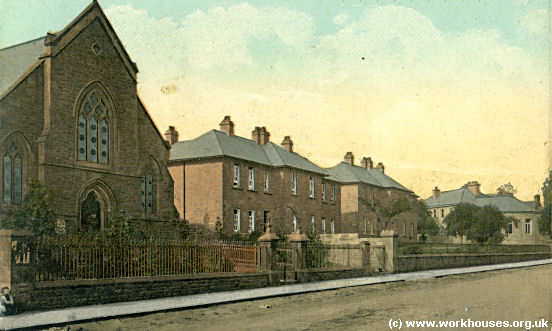
Lanchester cottage homes from the east, c.1910.
© Peter Higginbotham.
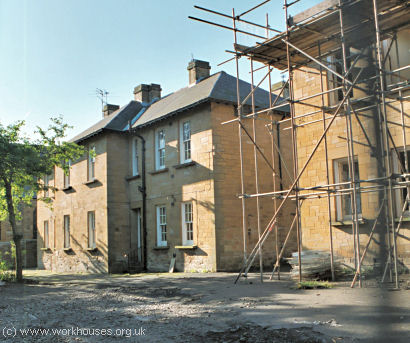
Lanchester cottage homes (Lee Hill Cottages) from the north, 2001.
© Peter Higginbotham.
The cottage homes have now been refurbished for residential use.
Staff
Inmates
Records
Note: many repositories impose a closure period of up to 100 years for records identifying individuals. Before travelling a long distance, always check that the records you want to consult will be available.
- Durham County Record Office, County Hall, Durham DH1 5UL. Few local records survive. Holdings include some creed registers, and registers of births and deaths.
Bibliography
- Higginbotham, Peter The Workhouse Encyclopedia (2014, The History Press)
Links
Unless otherwise indicated, this page () is copyright Peter Higginbotham. Contents may not be reproduced without permission.


